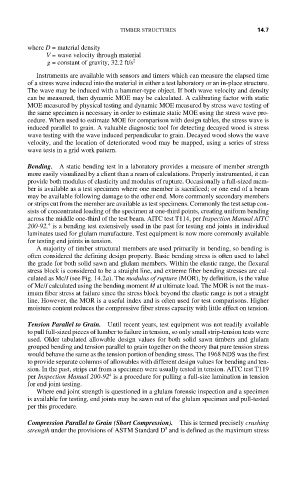Page 516 - Forensic Structural Engineering Handbook
P. 516
TIMBER STRUCTURES 14.7
where D = material density
V = wave velocity through material
g = constant of gravity, 32.2 ft/s 2
Instruments are available with sensors and timers which can measure the elapsed time
of a stress wave induced into the material in either a test laboratory or an in-place structure.
The wave may be induced with a hammer-type object. If both wave velocity and density
can be measured, then dynamic MOE may be calculated. A calibrating factor with static
MOE measured by physical testing and dynamic MOE measured by stress wave testing of
the same specimen is necessary in order to estimate static MOE using the stress wave pro-
cedure. When used to estimate MOE for comparison with design tables, the stress wave is
induced parallel to grain. A valuable diagnostic tool for detecting decayed wood is stress
wave testing with the wave induced perpendicular to grain. Decayed wood slows the wave
velocity, and the location of deteriorated wood may be mapped, using a series of stress
wave tests in a grid work pattern.
Bending. A static bending test in a laboratory provides a measure of member strength
more easily visualized by a client than a ream of calculations. Properly instrumented, it can
provide both modulus of elasticity and modulus of rupture. Occasionally a full-sized mem-
ber is available as a test specimen where one member is sacrificed; or one end of a beam
may be available following damage to the other end. More commonly secondary members
or strips cut from the member are available as test specimens. Commonly the test setup con-
sists of concentrated loading of the specimen at one-third points, creating uniform bending
across the middle one-third of the test beam. AITC test T114, per Inspection Manual AITC
4
200-92, is a bending test extensively used in the past for testing end joints in individual
laminates used for glulam manufacture. Test equipment is now more commonly available
for testing end joints in tension.
A majority of timber structural members are used primarily in bending, so bending is
often considered the defining design property. Basic bending stress is often used to label
the grade for both solid sawn and glulam members. Within the elastic range, the flexural
stress block is considered to be a straight line, and extreme fiber bending stresses are cal-
culated as Mc/I (see Fig. 14.2a). The modulus of rupture (MOR), by definition, is the value
of Mc/I calculated using the bending moment M at ultimate load. The MOR is not the max-
imum fiber stress at failure since the stress block beyond the elastic range is not a straight
line. However, the MOR is a useful index and is often used for test comparisons. Higher
moisture content reduces the compressive fiber stress capacity with little effect on tension.
Tension Parallel to Grain. Until recent years, test equipment was not readily available
to pull full-sized pieces of lumber to failure in tension, so only small strip-tension tests were
used. Older tabulated allowable design values for both solid sawn timbers and glulam
grouped bending and tension parallel to grain together on the theory that pure tension stress
would behave the same as the tension portion of bending stress. The 1968 NDS was the first
to provide separate columns of allowables with different design values for bending and ten-
sion. In the past, strips cut from a specimen were usually tested in tension. AITC test T119
4
per Inspection Manual 200-92 is a procedure for pulling a full-size lamination in tension
for end joint testing.
Where end joint strength is questioned in a glulam forensic inspection and a specimen
is available for testing, end joints may be sawn out of the glulam specimen and pull-tested
per this procedure.
Compression Parallel to Grain (Short Compression). This is termed precisely crushing
5
strength under the provisions of ASTM Standard D and is defined as the maximum stress

